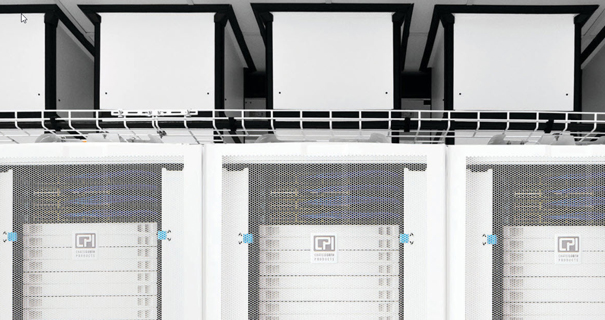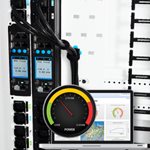Thinking Inside the Box
October 01, 2021
As global demand for connectivity continues to skyrocket, data centre densities are following suit. In this always on world, there are a number of factors contributing to this increase. Power loads are becoming less predictable and the continual development of new technologies and services such as the internet of things (IoT), 5G wireless and edge computing is putting a strain on data centre operations. Because of these factors, data centre managers are adding capacity to stay ahead of the curve.
PHYSICAL FOOTPRINT
It is important to address the data centre holistically. A well designed, cohesive infrastructure enables efficient management and flexibility, giving data centre managers the ability to achieve total data centre optimisation. This holistic approach begins with the cabinet ecosystem.
The fundamental purpose of a data centre cabinet is to house mission critical IT equipment, allowing additional space for cable organisation and airflow management. Additionally, the cabinet must also house power management hardware, which allows for reliable power distribution within the cabinet and may include intelligent capabilities for remote monitoring and control. Within the cabinet, every bit of space counts.
SPACE RACE
With many organisations turning to remote working and customer expectations of continuous, fast data reaching an all-time high, ICT infrastructure needs will not remain static. However, the more recent challenge that data centre managers face is the availability of scalable space for data centre cabinets.

Data centre real estate is in short supply, so organisations have been forced to make the most of their existing footprints. Even though it’s important to maximise data centre space, it’s just as important to invest in wider and deeper cabinets than the equipment they house, so they can also support proper power, cable and airflow management.
With more equipment per cabinet, load rating becomes critical. It is no surprise that data centre cabinets need to have a robust design with high load ratings. Advanced data centre cabinets feature incredibly high static ratings of 1814kg (4000lb) to 2268kg (5000lb) of equipment. For ‘rack and stack’ deployments – the option for sites that practice cabinet level deployment and utilise system integrators to load equipment into the cabinet and then deploy the integrated cabinet to the site – modern cabinets now feature high rolling loads of 1814kg (4000lb) and include heavy duty casters that support those loads.
MONITOR AND MANAGE
A data centre’s power capabilities are critical for keeping IT infrastructure up and running – particularly with more processing being done within every cabinet. Power distribution, monitoring and control at the cabinet level are all critical to ensuring the availability and uptime of IT applications, as well as minimising the overall energy footprint of the data centre. Reducing data centre cooling costs is a high priority among most data centre operators. The right cabinets should provide cooling and airflow management space to ensure optimal energy efficiency.
An effective thermal management strategy that utilises practical concepts such as passive cooling promotes better energy efficiency and lowers costs in high density operations. There are several factors that affect the performance of the data centre. One of the most common causes of downtime and the shortening of life of equipment is hardware failure due to exceeding temperature or humidity levels within a cabinet. The ability to monitor these environmental conditions to optimise efficiency, and identify and address any issues before they result in downtime, is a key component in any data centre management strategy.
PROTECTING ASSETS
The need for physical security is critical and protecting personal and business data from theft has become an issue of paramount importance. Locking cabinet doors provides basic protection, whereas investing in networked electronic access control solutions offers numerous benefits. Access to IT equipment within cabinets must be properly controlled and managed, and a networked electronic access control solution at the cabinet level prevents unauthorised physical access. It also provides administrators with an audit trail of all authorised and unauthorised access attempts for regulatory compliance and incident response.
To simplify operations and reduce supply chain complexities, data centre managers should look for market solutions that integrate power distribution, environmental monitoring and access control in the same platform, using minimal network connections. This means three vital tasks that are typically deployed from different vendors – power management, environmental monitoring and access control – can now be integrated into a single hardware solution.
LIFE THROUGH A LENS

It is often said that a data centre infrastructure management (DCIM) software solution is the lens for gaining better visibility into the health of data centre assets and their operation. Simply put, DCIM software helps to visualise trends in the room and cabinet, all on a single screen and dashboard. Today’s DCIM solutions include monitoring, asset management, change management and other digital tools to help data centre managers optimise cost and performance.
To achieve proper cable management, data centre managers can deliver optimal signal quality and transmission speed by eliminating kinks, twists and sharp ends. Today’s advanced data centre cabinets must provide specific and physically separate pathways for power and network cables to ensure network integrity with minimal airflow interference.
TASK AT HAND
Those tasked with managing and implementing networks that deliver always on connectivity are quickly learning to embrace a new approach to managing data centre assets and white space remotely. By opting for a single source solutions provider, data centre managers stand to benefit from implementing customised cabinet solutions that simplify provisioning, accelerate deployment and ensure all of the elements of the data centre cabinet ecosystem are compatible.
This article was originally published in the October 2021 issue of Inside Networks magazine.